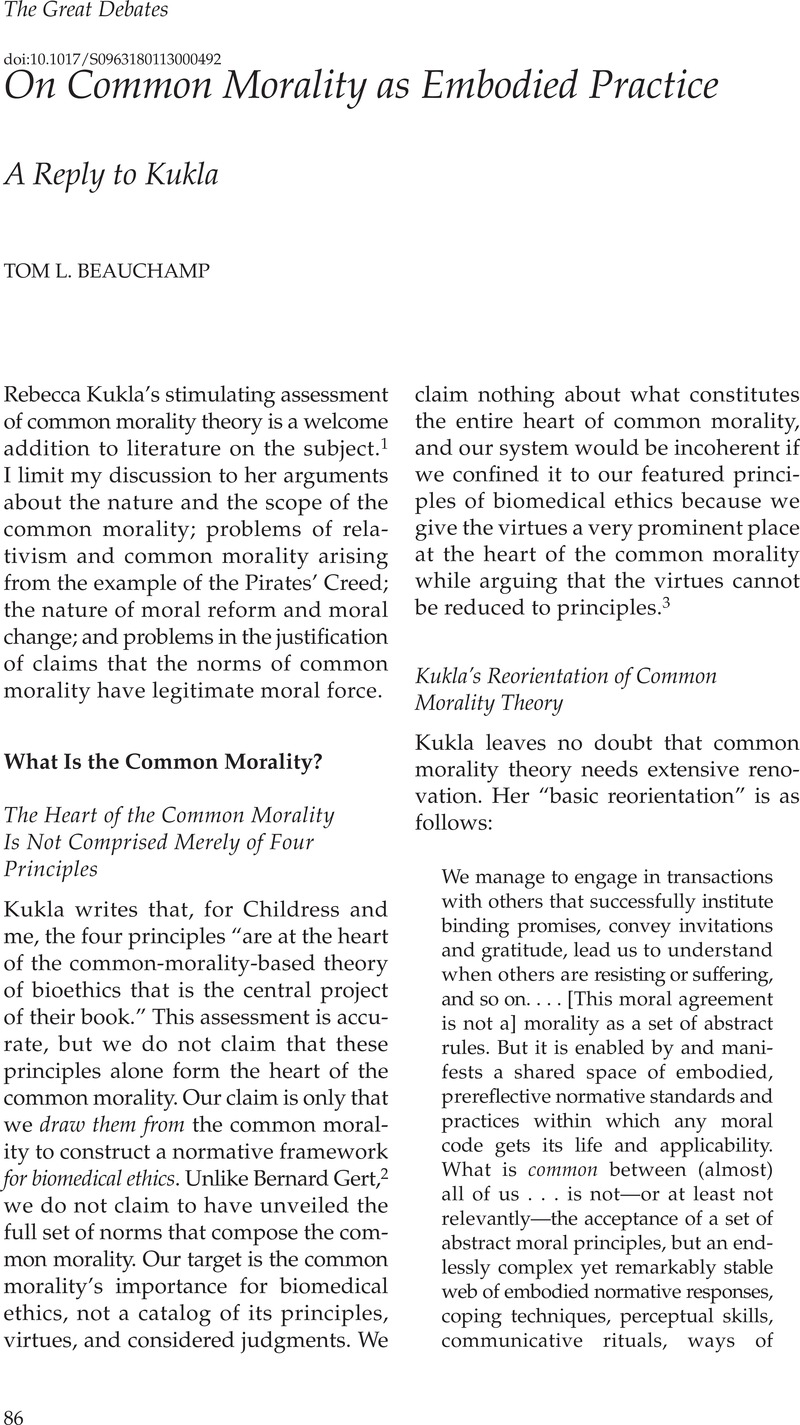A Reply to Kukla
Published online by Cambridge University Press: 20 November 2013

1. Kukla, R. Living with pirates: Common morality and embodied practice. Cambridge Quarterly of Healthcare Ethics 2014;23:75–85.Google Scholar
2. Gert, B. Morality: Its Nature and Justification. 2nd rev. ed. New York: Oxford University Press; 2005.Google Scholar
3. See Beauchamp, TL, Childress, J. Principles of Biomedical Ethics. 6th ed. New York: Oxford University Press; 2009Google Scholar, chap. 1 and 2 (and also chap. 9 in the forthcoming seventh edition), esp. chap. 1, p. 3.
4. See note 3, Beauchamp, Childress 2009, at 9, 13–14, 16–17, 370.
5. See note 3, Beauchamp, Childress 2009, at 387–9.
6. Arras, J. The hedgehog and the Borg: Common morality in bioethics. Theoretical Medicine and Bioethics 2009;30:11–30, at 12.Google Scholar
7. See note 3, Beauchamp, Childress 2009, at 384.
8. For context see note 3, Beauchamp, Childress 2009, chap. 10, section on “Moral Change.”
9. See note 2, Gert 2005, at 114–15; Gert, B, Culver, CM, Clouser, KD. Bioethics: A Systematic Approach. New York: Oxford University Press; 2006, at 104.Google Scholar
10. Hobbes, T. Leviathan. Curley, Edwin, ed. Indianapolis: Hackett; 1994, chap. 13.Google Scholar
11. See note 3, Beauchamp, Childress 2009, at 392. The structure of the argument in chapter 10 is a defense of reflective equilibrium and considered judgments as the proper model of justification.
12. See note 3, Beauchamp, Childress 2009, at 394. Also, in chapter 1, we sharply distinguish normative and nonnormative approaches to ethics and try to keep distinct the notions of legitimate force and universal acceptance.
13. Beauchamp, TL. Standing on Principles: Collected Essays. New York: Oxford University Press; 2010Google Scholar, at 181 (reprint of a 2003 article).
14. In appealing to this notion, I agree with the many cautions about whether it is suitable in Strong C. Theoretical and practical problems with wide reflective equilibrium in bioethics. Theoretical Medicine and Bioethics 2010;31:123–40. I follow Rawls’s formulation of the notion in Rawls J. The independence of moral theory. Proceedings and Addresses of the American Philosophical Association 1974–75;48:5–22, §1.
15. See note 13, Beauchamp 2010, chap. 10–11; these chapters respond to David DeGrazia, Bernard Gert, Danner Clouser, and Leigh Turner. Arras correctly interprets our argument in Arras 2009, at 13 (see note 6), as does Rauprich in Rauprich, O. Common morality: Comment on Beauchamp and Childress. Theoretical Medicine and Bioethics 2008;29:43–71, at 67–8.Google Scholar
16. Foot, P. Moral Dilemmas. Oxford: Oxford University Press; 2002, at 6–7.CrossRefGoogle Scholar
17. See note 2, Gert 2005; Gert B. The definition of morality. The Stanford Encyclopedia of Philosophy (online); 2003 Apr 28. Available at http://plato.stanford.edu/entries/morality-definition/ (last accessed 24 Aug 2007).
18. For further discussion on this problem, see note 13, Beauchamp 2010, chap. 11.
19. For the distinction here used between the descriptive and the normative, see note 17, Gert 2003.